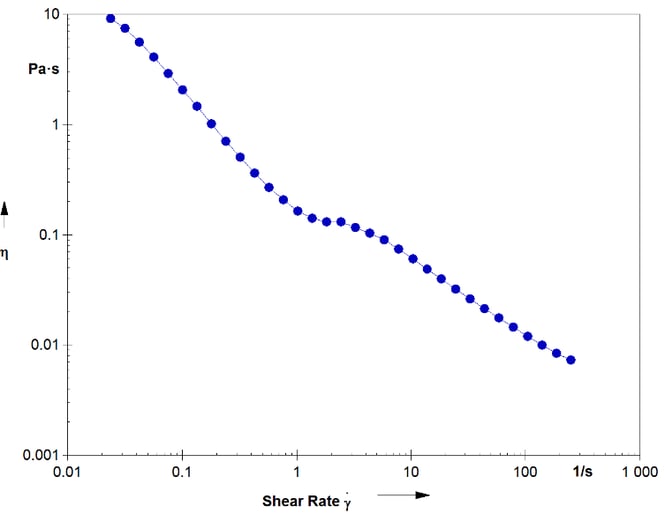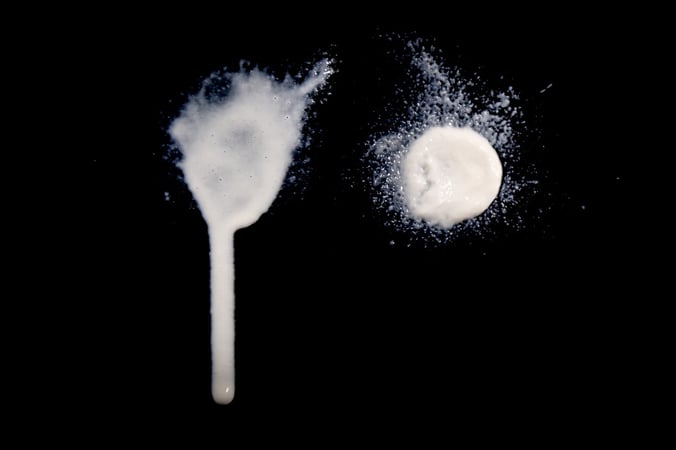
Important rheological properties of Exilva microfibrillated cellulose
Ole Martin Kristiansen | October 13, 2018
Rheology is the study of deformation and flow of material under stress, for example how easily material changes its form when it is pressed, or how easy it is to pump liquid in the pipes. Yield stress and viscosity are two importance aspects in the study of rheology and I will today exemplify this by using the Exilva microfibrillated technology.
High viscosity and extremely shear thinning behavior
One of the most well known aspects of rheology is viscosity. It describes materials ability to resist flow. In liquids, like water, it comes from the friction between the molecules which in turn is dependent, for instance, on the size of the molecules and interactions between them.
Suspensions of cellulose fibrils, like Exilva microfibrillated cellulose (Exilva MFC), are slightly more complicated since it consists of two different components: cellulosic fibers and the surrounding water (in an end-application there can be even more components). Water in itself has very low viscosity, but a small amount of Exilva MFC well dispersed in water changes the whole picture: The resulting suspension has much higher viscosity. There are two reasons for that. First, any particles in liquid increase the viscosity since they disturb the flow field of the liquid. Second, the Exilva microfibrillated cellulose are not as single fibers in the suspension, but instead, they form a continuous, strong network that resists flow effectively. As a result, the viscosity of the suspension is very high.
So, this network explains the high viscosity of Exilva MFC suspension at rest. However, if we apply force on the suspension, let’s say we start mixing it with a spoon, this network breaks, and the viscosity goes down. The more force we put on the suspension, the more the viscosity decreases. This effect, shear thinning, is one of the very visible effects from Exilva MFC. This in turn is how very high viscous suspensions can be pumped or even sprayed. As shown in the figure below, it flows easily under shear, and when the shearing is stopped, the fiber network regains its structure. As a consequence of this, the viscosity returns to (or almost back to) its original value prior to shear being applied.

Figure 1. Graph showing the shear thinning behavior of 0.5% cellulose fibrils (Exilva, MFC from Borregaard) suspension in water: Viscosity drops from 10 Pas to 0.01 Pas when shear rate is increased from 0.025 to 250 s-1.
Interested in how the cellulose fibrils, like the Exilva microfibrillated cellulose, compares to other rheology additives you should read these:
- How to compare rheology additives: nanocellulose/cellulose fibrils and HEUR
- How to compare rheology additives: nanocellulose/cellulose fibrils and HASE
- Cellulose fibrils vs. fumed silica: characteristics and applications

"This in turn is how very high viscous suspensions with cellulose fibrils, exemplified by Exilva MFC can be pumped or even sprayed". This image shows how a product with cellulose fibrils, to the right, immediately recover its structure after easily being sprayed.
High Yield Stress
The Exilva microfibrillated cellulose network requires quite high force to start flowing. In rheological terms, the required force per certain area to initiate flow is called yield stress. Exactly how much force is required to break the network is dependent on how many contact points there are between the fibres and how strong interactions there are at these contact points.
In practice, at least the following things affect the strength of the network: concentration of Exilva microfibrillated cellulose in water, how well the fibres are dispersed, concentration of salts in the suspension, possible other components, pH… The highest gel strength is achieved when the fibres are well dispersed, but they still have strong interactions with each other.
--> Read also: Dispersion of Cellulose Fibrils - a Critical Success Factor
High yield stress makes Exilva MFC a good stabiliser of suspensions or emulsions since it can trap particles or droplets in the network and prevent them from sinking or floating.
Editor's note: This blog post was originally posted in August 2016 and written by Anni Karppinen. We've revamped and updated it for accuracy and comprehensiveness.